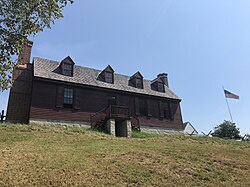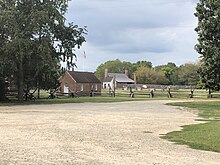
Stafford County is located in the Commonwealth of Virginia. It is a suburb outside of Washington D.C. It is approximately 40 miles (64 km) south of D.C. It is part of the Northern Virginia region, and the D.C. area. It is one of the fastest growing, and highest-income counties in America. As of the 2020 census, the population sits at 156,927. Its county seat is Stafford.
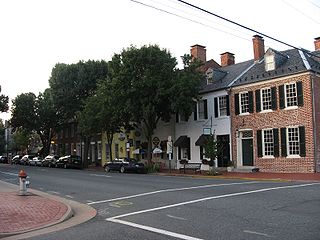
Fredericksburg is an independent city in Virginia, United States. As of the 2020 census, the population was 27,982. It is 48 miles (77 km) south of Washington, D.C., and 53 miles (85 km) north of Richmond. The Bureau of Economic Analysis of the United States Department of Commerce combines the city of Fredericksburg with neighboring Spotsylvania County for statistical purposes.

Caroline County is a United States county located in the eastern part of the Commonwealth of Virginia. The northern boundary of the county borders on the Rappahannock River, notably at the historic town of Port Royal. The Caroline county seat is Bowling Green.

Falmouth is a census-designated place (CDP) in Stafford County, Virginia, United States. Situated on the north bank of the Rappahannock River at the falls, the community is north of and opposite the city of Fredericksburg. Recognized by the U.S. Census Bureau as a census-designated place (CDP), Falmouth's population was 4,956 as of the 2020 census.

The Northern Neck is the northernmost of three peninsulas on the western shore of the Chesapeake Bay in the Commonwealth of Virginia. The Potomac River forms the northern boundary of the peninsula; the Rappahannock River demarcates it on the south. The land between these rivers was formed into Northumberland County in 1648, prior to the creation of Westmoreland County and Lancaster County. The Northern Neck encompasses the following Virginia counties: Lancaster, Northumberland, Richmond, King George and Westmoreland; it had a total population of 50,158 as of the 2020 census.

Mason Locke Weems, usually referred to as Parson Weems, was an American minister, evangelical bookseller and author who wrote the first biography of George Washington immediately after his death. Some popular stories about Washington thought during the 20th century to be apocryphal can be traced to Weems, including the cherry tree tale. Weems' biography of Washington was a bestseller that depicted Washington's virtues and was intended to provide morally instructive tales for the youth of the young nation. Recent examinations of Weems, particularly by James Bish, and Dr. Richard Gardiner have found that Weems' knowledge and sourcing may have been stronger than assumed by previous scholars. Weems corresponded with Washington, had family ties to Washington, and evidently relied on members of the Washington family for information.

The George Washington Birthplace National Monument is a national monument in Westmoreland County, Virginia, at the confluence of Popes Creek and the Potomac River. It commemorates the birthplace location of George Washington, a Founding Father and the first President of the United States, who was born here on February 22, 1732. Washington lived at the residence until age three and later returned to live there as a teenager.
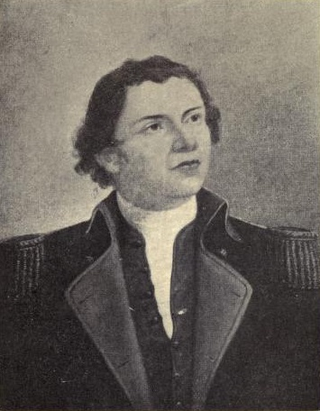
Hugh Mercer was a brigadier general in the Continental Army during the American Revolutionary War. He fought in the New York and New Jersey campaign and was mortally wounded at the Battle of Princeton.

William Fitzhugh was an American planter, legislator and patriot during the American Revolutionary War who served as a delegate to the Continental Congress for Virginia in 1779, as well as many terms in the House of Burgesses and both houses of the Virginia General Assembly following the Commonwealth's formation. His Stafford County home, Chatham Manor, is on the National Register for Historic Places and serves as the National Park Service Headquarters for the Fredericksburg and Spotsylvania National Military Park.

Chatham Manor is a Georgian-style mansion home completed in 1771 by farmer and statesman William Fitzhugh, after about three years of construction, on the Rappahannock River in Stafford County, Virginia, opposite Fredericksburg. It was for more than a century the center of a large, thriving plantation and the only private residence in the United States to be visited by George Washington, Thomas Jefferson, Abraham Lincoln, and Dwight D. Eisenhower.

Augustine Washington Sr. was an American planter and merchant. Born in Westmoreland, Virginia, he was the father of ten children, among them the first president of the United States, George Washington, soldier and politician Lawrence Washington, and politician Charles Washington. Born into the planter class of the British colony of Virginia, Washington owned several slave plantations, from which he derived the primary source of his wealth. He also speculated in land development and owned an iron mine. Although Washington never sat in the House of Burgesses, as did his own father and son, he served in various government positions in the counties where he owned land.

Charles Washington was an American planter and politician who founded a town in the Shenandoah Valley that was named Charles Town in his honor shortly after his death and that of his eldest brother, George Washington.

Samuel Washington was an American planter, politician and military officer best known for being the younger brother of the first president of the United States, George Washington.

Fielding Lewis was an American merchant, member of the House of Burgesses and a Colonel during the American Revolutionary War. He lived in Fredericksburg, Virginia and also owned a plantation in Spotsylvania County, which later became known as Kenmore. His brother-in-law was George Washington, who was also his 2nd cousin, he was also 2nd cousins with Betty Washington.
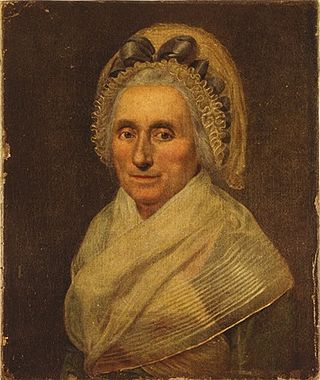
Mary Washington was an American planter best known for being the mother of the first president of the United States, George Washington. The second wife of Augustine Washington, she became a prominent member of the Washington family. She spent a large part of her life in Fredericksburg, Virginia, where several monuments were erected in her honor and a university, along with other public buildings, bear her name.

Elizabeth Washington Lewis was an American Colonist. She was the younger sister of George Washington and the only sister that survived childhood. Her half-sister, Jane, died at age 11 and her sister Mildred in infancy. Betty Washington was born into the Washington Family as the first daughter of Augustine Washington and Mary Ball Washington.

Kenmore, also known as Kenmore Plantation, is a plantation house at 1201 Washington Avenue in Fredericksburg, Virginia. Built in the 1770s, it was the home of Fielding and Betty Washington Lewis and is the only surviving structure from the 1,300-acre (530 ha) Kenmore plantation.
Philip Levy is an American historian and archaeologist. He received his Ph.D. in American History from William and Mary in 2001. He, along with David Muraca, is a co-leader of the excavation of Ferry Farm, the site of George Washington's childhood home. Levy and Muraca are credited with finding the foundations of the house where Washington was raised. He is an associate professor at the University of South Florida. His fields of research are Early America, Virginia History, Place and Landscape, Historical Archaeology, and Public History.
